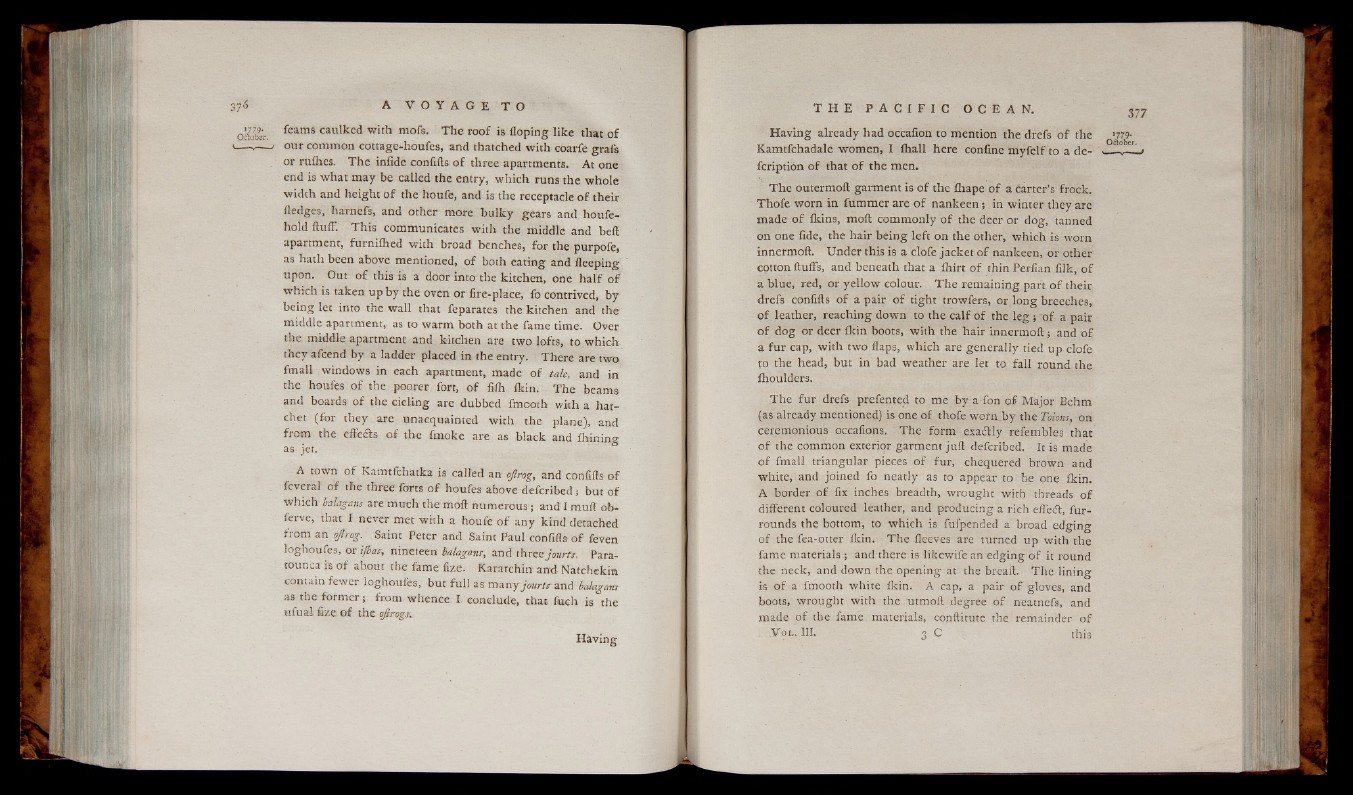
oa7Jbcr. feams caulked with mofs. The roof is doping lik e that o f
— .---- - our common cottage-houfes, and thatched with coarfe grafs
. or rallies. The infide conliils o f three apartments. At one
end is what may be called the entry, which runs the whole
width and height o f the houfe, and is the receptacle o f their
fledges, harnefs, and other more b u lk y gears and. houfe-
hold fluff. This communicates with the middle and beft
apartment, furniflied with broad benches, for the purpofe,
as hath been above mentioned, o f both eating and fleeping
upon. Out o f this is a door into the kitchen, one h a lf o f
which is taken up by the oven or fire-place, lb contrived, by
being let into the wall that feparates the kitchen and the
middle apartment, as to warm both at the fame time. Over
the middle apartment and kitchen are two lofts, to w hich
they afcend by a ladder placed in the entry. There are two
fmall windows in each apartment, made o f talc, and in
the houfes o f the poorer fort, o f filh Ikin. The beams
and boards o f the cieling are dubbed fmooth- with a hatchet
(for they are unacquainted with the plane), and
from the effetfls o f the fmoke are as black and ibiiring
as. jet.
A town o f Kamtfchatka is called an ojlrog, and confifls- o f
feveral o f the three forts o f houfes above defcribed; but o f
w hich Mctgam are much the moft numerous; and I mail ob-
ferve, that I never met with a houfe o f any kind detached
from an ajlrog. Saint Peter and Saint Paul confifls o f feven
loghoufes, or ijbas., nineteen balaganr, and three jonrts. Para-
rounca is o f about the fame fize. Kararchin and- Natchekia
contain fewer loghoufes, bur full as manyjaurU and bahgam
as the: fo rm e r ; from whence I conclude, that fuch is the
ufual fize o f the ofiroga
Having
Having already had occafion to mention the drefs o f the
Kamtfchadale women, I fhall here confine m y fe lf to a de-
fcription o f that o f the men.
T h e outermoft garment is o f the lhape o f a carter’s frock.
Thofe worn in fummer are o f nankeen ; in winter they are
made o f Ikins, moft commonly o f the deer or dog, tanned
on one fide, the hair being left on the other, which is worn
innermoft. Under this is a clofe jacket o f nankeen, or other
cotton fluffs, and beneath that a ihirt o f thin Perfian filk, o f
a blue, red, or ye llow colour. T he remaining part o f their
drefs confifls o f a pair o f tight trowfers, or long breeches,
o f leather, reaching down to the c a lf o f the leg ; o f a pair
o f dog or deer ikin boots, with the hair innermoft; and o f
a fu r cap, with two flaps, which are generally tied up clofe
to the head, but in bad weather are let to fall round the
ihoulders.
The fur drefs prefented to me by a fon o f Major Behm
(as already mentioned) is one o f thofe worn.by the Toions, on
ceremonious occafions. The form e x a itly refembles that
o f the common exterior garment juft defcribed. It is made
o f fmall triangular pieces o f fur, chequered brown and
white, and joined fo neatly as to appear to be one ikin.
A border o f fix inches breadth, wrought with threads o f
different coloured leather, and producing a rich effect, fur-
rounds the bottom, to which is fufpended a broad edging
o f the fea-otter Ikin. The fleeves are turned up with the
fame materials ; and there is likewife an edging o f it round
the neck, and down the opening at the breaft. T he lining
is o f a fmooth white ikin. A cap, a pair o f gloves, and
boots, wrought with the utmoft degree o f neatnefs, and
made o f the fame materials, conftitute the remainder o f
V ol. III. 3 C this
1779-
O é lo b e r .